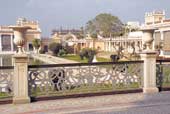 |
| TREASURE TROVE: A view of the Chowmahalla Palace |
 |
| An Urdu typewriter |
 |
| A gramophone |
 |
| The Durbar Hall |
 |
| A tableau depicting a sitting room (Pix: B.K. Ramesh) |
Every time Anuradha Naik returned home to Hyderabad, once in three months or so, she’d find an old building gone. The city had been changing dramatically and the young conservation architect from Edinburgh mourned the disappearance of those old, familiar landmarks. “I wanted to do something for Hyderabad, for I didn’t want my grandchildren to grow up in a city that only had malls,” she says.
And that explains the element of quiet pride in her eyes as she watches the resurrection of a grand old palace in the heart of the city. After all, she has done her bit in restoring the 18th century Chowmahalla Palace of the Nizams of Hyderabad — now a public museum.
You have been warned, but the sudden sight of the imposing and elegant structure — white, wide-arched and intricately carved — still comes as a surprise. The concrete flyovers of Hyderabad have led you to the congested old city area, brimming with people and shops. And in the midst of it — right in the heart of a busy bangle market — stands the Chowmahalla Palace.
“It’s a small oasis of beauty in crowded Hyderabad. You turn into it, and say, my God,” says Shobita Punja, a member of the Indian National Trust for Art and Cultural Heritage (INTACH). She is also a soldier in the passionate army that has restored the palace that’s increasingly being referred to as a top-of-the-class museum.
For over 40 years, the palace was under lock and key. Six years ago, Princess Ezra — the first wife of the seventh Nizam’s grandson — got in touch with conservationist Martand Singh, the chairman of INTACH, UK. She wanted the palace to be turned into a museum, and funded the multi-crore-rupee project. “The Princess wanted to give something back to the people of Hyderabad,” says Martand Singh.
The palace gates were unlocked, and the restoration began. Parts of the palace — which once stood on 42 acres of land but is now on 12 acres — had to be demolished, and a large part reconstructed. The museum was gradually introduced to the public, with a new gallery being opened last month.
The before-and-after pictures on Punja’s desk tell their own story. Six years ago, the palace was a dead building. Today, it stands regally in the midst of a green expanse, dotted with the white-and-cream flowering shrubs of hibiscus and frangipani.
The ticketed museum is an ode to the Nizams, the rulers of the Hyderabad dominion. A section is devoted to the rulers, tracing their links to the city and its people.
“The seventh Nizam was known as the richest man in the world,” says museum director G. Kishan Rao. “People know him as someone who threw lavish parties and had paperweights made out of diamonds. But he was also the man who donated generously,” he says. Though often called a miser, he donated 14,000 acres to the Bhoodan movement.
The khilwat — or the durbar hall — glitters with the light of 19 Belgian chandeliers, encircling the Nizam’s seat of marble. A gallery holds up ancient maps; another showcases old arms — swords and daggers with gold-and-ruby inlaid hilts safely ensconced in glass chambers. A gallery has vignettes of the Nizams’ lives — an old gramophone with an Elvis Presley 78 RPM, an Urdu typewriter that moves from left to right, a beautifully carved writing table and so on.
There are some rare photographs too, including some of the women of the Asaf Jah dynasty, never ever seen by outsiders. A gallery displays a tableau on the life of the palace women. Quite a few don the khara dupatta — a four-piece ensemble that includes a trailing dupatta. There is one dupatta, adorned with intricate zari work, that weighs 17 kg.
When the restorers started work, they found a closet full of top hats, and another with bow ties. Pictures were unearthed, restored and some digitally enlarged. Iranian scholars pored over old manuscripts and translated them, while the nimble fingers of ancient darners repaired bales of rich cloth.
The city’s begums came to help and draped specially-made, small-sized mannequins in heavy silks in the traditional Hyderabadi style. And Martand Singh put into practice a trick that he had learnt in the United States: the delicate clothes were held up with mosquito nets.
A battery of people — consisting of the best of conservation architects, museuologists and experts in textiles, manuscripts, photographs and exhibitions in the country — was pressed into service. “Twenty years ago, there were no conservationists in India,” says Punja. But today, she adds, India has able professionals, mostly trained abroad.
And that’s the reason the Chowmahalla is being seen as a museum that meets global standards. The chairman of the Scottish Heritage Trust has appreciated the museum, and a representative of the Metropolitan Museum of Art in New York has sent the restorers a letter of admiration. If she had known — she writes — that this kind of work was going to be done in India, she would never have left for the US. Last week, art historian Stuart Cary Welch visited Chowmahalla. Author-historian William Dalrymple was there the week before.
A bit of work is still left. Anuradha Naik is overseeing a model of the city to be placed in the museum. There will be an archival section. Old buggies have to be repaired and put on display. And work is on to restore a part of the palace for the private use of the Asaf Jah family. Two Austrian men have polished the furniture, and a designer has come from England to do the curtains — all in apricot gold.
At the end of the day, those behind the museum hope to revive the links of the people with a forgotten era. “After all, you can’t have places without people, and people without places,” says Singh.











